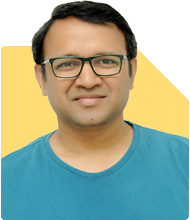Ulhas Joshi |280 Answers |Ask -Follow
Mutual Fund Expert - Answered on Aug 23, 2023
Prior to joining RankMF as CEO, he was vice president (sales) at IDBI Asset Management Ltd.
Joshi holds an MBA in marketing from Barkatullah University, Bhopal.... more

Hi ! I am a retired person 62 yrs old . Recently I sold my equity portfolio , so I am having a spare corpus of about 60-70 lacs . I had kept this amount solely for equity/MF investments as I had also invested in FDs /Gold bonds separately .I want to invest it in an instrument which can give me less risk/good returns (above FDs & inflation beating ) , say about 9-10 % to the least in next 3 year & even better returns in the long run in my seventies /Eighties . Please illuminate me on the following- 1. Is it desirable to put this entire amount in MFs or there should be some direct investment in equities also ? 2. If Yes , what should be the ideal mix of portfolio for me ?Should it have equity ( Large cap /Mutli cap) or Balance Hybrid funds will be more suitable from the risk angle as I am a retired person ? .Please suggest an ideal mix with category & names of fund with the amount to be invested . 3.If no , then please suggest alternatives . Thanks & Regards Apurv Chandra
Note that I only discuss mutual funds in this column and so will not advise for or against any other asset classes.
To generate inflation beating returns, given that you are retired and would not like to take undue risk, I believe a mix of balanced advantage funds and multi asset funds will be ideal to invest in for a period of around 3 years. Starting SWP's from those schemes after 3 years will help you meet living expenses while your corpus continues to grow.
You can consider investing your funds equally in:
1-ICICI Prudential Regular Savings Fund
2-SBI Conservative Hybrid Fund
3-Tata Balanced Advantage Fund
4-Aditya Birla Sun Life Balanced Advantage Fund
5-Nippon India Multi Asset Fund
You may like to see similar questions and answers below
Omkeshwar Singh | Answer |Ask -Follow
Head, Rank MF - Answered on Dec 07, 2021
Ramalingam Kalirajan |10894 Answers |Ask -Follow
Mutual Funds, Financial Planning Expert - Answered on Sep 10, 2024
Nitin Narkhede |113 Answers |Ask -Follow
MF, PF Expert - Answered on Sep 14, 2024
Reetika Sharma |425 Answers |Ask -Follow
Financial Planner, MF and Insurance Expert - Answered on Nov 21, 2025
Patrick Dsouza |1429 Answers |Ask -Follow
CAT, XAT, CMAT, CET Expert - Answered on Dec 16, 2025
Nayagam P P |10858 Answers |Ask -Follow
Career Counsellor - Answered on Dec 16, 2025
Nayagam P P |10858 Answers |Ask -Follow
Career Counsellor - Answered on Dec 16, 2025
Samraat Jadhav |2510 Answers |Ask -Follow
Stock Market Expert - Answered on Dec 16, 2025
Samraat Jadhav |2510 Answers |Ask -Follow
Stock Market Expert - Answered on Dec 16, 2025
Nayagam P P |10858 Answers |Ask -Follow
Career Counsellor - Answered on Dec 16, 2025
Nayagam P P |10858 Answers |Ask -Follow
Career Counsellor - Answered on Dec 16, 2025
Ramalingam Kalirajan |10894 Answers |Ask -Follow
Mutual Funds, Financial Planning Expert - Answered on Dec 16, 2025
Nitin Narkhede |113 Answers |Ask -Follow
MF, PF Expert - Answered on Dec 15, 2025
Nitin Narkhede |113 Answers |Ask -Follow
MF, PF Expert - Answered on Dec 15, 2025






























